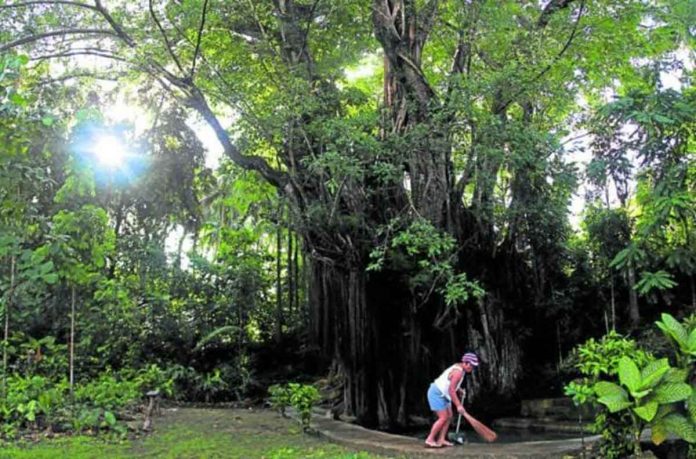
MANILA — Sixteen-year-old Enola (not her real name) recalled how she felt her skin crawl every time she took a peek at the “balete” tree towering a few meters away from her classroom.
It didn’t help when the security guard at her school in General Trias City, Cavite province, warned schoolchildren not to get too close to the tree with the creepy hanging roots because it “ate people up.”
They were told it was the dwelling place of supernatural monsters like the half-man, half-horse “tikbalang” and the tree giant “kapre,” along with the “diwata” (fairy) and “dwende” (dwarf).
One day, Enola saw a “mariposa” butterfly, which seemed bigger than its usual size, fluttering out of the balete’s hollow trunk.
The girl and her classmates crowded around it for a closer look and concluded, as children would, that a diwata must be living inside the balete and shape-shifted into that butterfly.
“Back then, I personally just wanted the tree to be gone so I could get it off my mind,” Enola said.
A staple in horror stories in popular culture and folklore in the Philippines, the balete tree has been the object of fright and fascination among Filipinos for decades, even centuries.
‘Residence of spirits’
According to University of the Philippines (UP) anthropology professor Felipe Jocano Jr., this dates back to the Spanish colonial period when priests and friars preached against indigenous religions and superstitious beliefs.
“The tree itself was always regarded as the home of the spirits,” Jocano told the Inquirer, noting that the balete is a known “residence of spirits” based on ancient stories. “Spirit beings were a familiar part of the natural environment,” he said.
In some ways, the fear of the balete has benefited the species, as it has kept humans at bay.
It may well be the reason why it is considered the “least endangered” of all native trees in the country, according to Lillian Rodriguez, an assistant professor of ecology and taxonomy also at UP.
Balete trees help sustain Philippine rainforests, being a source of staple food for hundreds of wildlife species.
‘Sacrifice’
While Filipinos fear the balete tree, the local name of several species of figs from the genus Ficus, its close relative, the banyan tree, or strangler fig, is revered and even worshiped elsewhere, including by Buddhists in parts of Asia, such as Thailand and Cambodia.
They hold the banyan tree in high regard, as it is believed Buddha achieved enlightenment while he was meditating under its shade.
As for the balete, the tree has always been considered to be “connected” to the spiritual world by Filipinos, said Jonathan Carl Salazar, a member of the Philippine Native Tree Enthusiasts, who specializes in the balete.
Salazar said locals had long believed that cutting down the tree would require a “sacrifice” — often the life of the perpetrator.
Others say that playing around the balete tree or making noise in the vicinity might disturb the creatures lurking inside.
“For me, we should also hold the balete trees in high regard to prevent any threats,” Salazar said.
One way of giving respect to the balete tree would be to utter the words “tabi tabi po” or “excuse me,” he said, “so as not to experience any supernatural effects.”
‘Strangled to death’
Under folk traditions, the balete tree is seen as a “palace in itself,” Jocano said, as those taken or lost in it were bound to enter a “totally different world.”
Deep in the forest, the balete tree is clearly distinguishable from other trees, making it easy to locate for birds and insects that look at it as food source.
While myths surrounding the balete may not be grounded in science, its biological life cycle may qualify as a horror story of its own.
As it grows, the tree continues to shoot its roots down to the ground, giving it its distinct appearance, Rodriguez said.
Once they reach the forest floor, the roots receive “more nutrition” from the soil, eventually thickening enough to “suffocate” the host tree, Rodriguez said. The host tree begins to wither and die because of “indirect competition.”
“This is why the insides of mature balete trees are hollow because there was once a tree inside the center of the balete,” she explained.
This may be the scientific reason for Filipinos’ fear of the balete tree, “because life was once inside it but the balete tree strangled it to death.”
The ecology professor said it was “fortunate” that Filipinos feared the native tree.
‘We let them be’
“We leave them as is. We refrain from cutting them, thinking we might offend the spirits living inside these trees,” she said. “As a result, we preserve their diversity. We let them be and they continue providing food for our native fauna.”
But Rodriguez said such treatment should extend to other tree species, as she called on the government to “put its foot down” on illegal logging, especially within the country’s protected areas.
“Commercialism and greed know no bounds,” Rodriguez lamented. “Habitat conversion and illegal logging will always be huge threats to all our trees, the balete trees included,” she said (Dempsey Reyes © Philippine Daily Inquirer)






